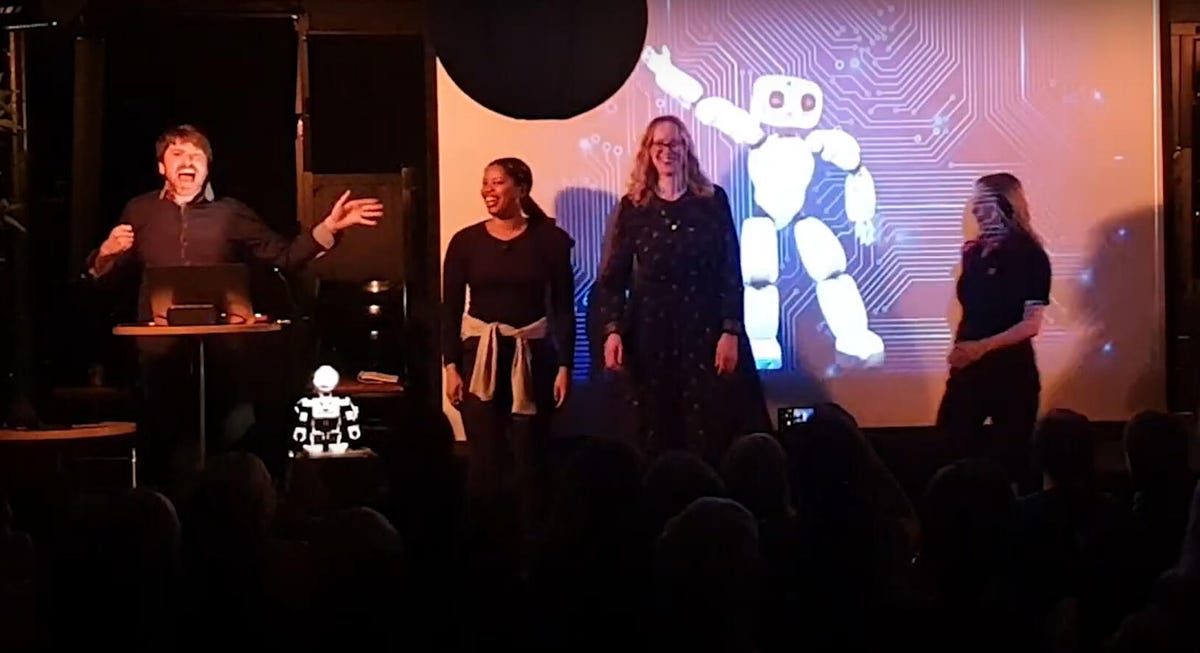In a dusty basement, in front of about 100 amused onlookers, sex robot Vanessa 5000 shows off her sexy dance and her preprogrammed personalities for particular tastes. Like all technology, she sometimes needs a reboot, like when she gets stuck gyrating on the floor. A gentle spanking from an audience member in the front row does the trick.
That performance was a highlight of the third consecutive Edinburgh Fringe event I attended where a robot took center stage. But unlike the earlier robots, Vanessa 5000 wasn’t actually made from chips and wires – in spite of what the charging cable hanging down from the back of her neck would’ve had you believe.
Vanessa 5000 was in fact LA-based comedian and clown Courtney Pauroso, who spent the entirety of August waving her not-so-synthetic bare butt cheeks before audiences at the world’s largest arts festival. A skilled physical theater performer, Pauroso was one of multiple artists who brought shows about artificial intelligence to the Edinburgh Fringe festival this year.
The timing was apt, as workers in the entertainment industry across the US strike to protect their livelihoods, in part from the perceived threat that generative AI – think ChatGPT – will steal their jobs. Broadly speaking, AI describes the ability of machines to do things that usually require human intelligence. Generative AI’s spin is that it uses the massive amounts of data at its disposal to generate new material, such as pictures, text, video and, in the case of the arts, scripts.
The rise of generative AI has been one of the most important recent technology breakthroughs, and it isn’t just people in Hollywood who are alarmed. Many are worried about the potential for massive disruptions across fields including law, journalism and education. But there are also those who see an opportunity to use gen AI for innovations in creativity and artistry.
The monthlong Edinburgh Fringe festival, which first took place in 1947, has a storied history of holding up a mirror to society, reflecting back its greatest fears and biggest questions – albeit softened by wisecracks and punchlines. It serves as a forum for musing over the big issues that have defined the previous year’s news cycle, and it provides space for artists and their audiences to work through their feelings about what’s happening in the wider world.

An Improbotics performance in April 2023 at an improv festival in Oslo, Norway. Alex the robot is at left, in front of the lectern.
According to Mirowski, there’s a difference between previous Improbotics audiences and those who came to view his work in August. In the past, the lack of expectations and the general skepticism that AI would work at all meant audiences were more likely to cheer on Alex the robot. More recently, many audience members have played with generative AI tools at home, and so they have a better idea of what the tools can do. Plus, he said, they’re more likely to be worried about the threat to their jobs.
In an interview, Mirowski told me he’s been pondering a big ethical question throughout the Fringe festival: how to emphasize to audiences that using AI in the creative process still requires direction from skilled performance artists. “How do we convey the message these tools should be used to create a first draft but not to create a final product?” he asked.
After all, ChatGPT and its ilk, for all their seeming authority, are known for providing wrong, incomplete or “hallucinated” answers. “We’re cognizant of the fact that there can be an impoverishment of our cultural capital if we just start over-relying on these tools instead of finding new ideas,” said Mirowski.
Missing the human connection
To recall what a physical experience it is to be human – an experience no artificial intelligence can truly understand or replicate – there’s nothing quite like attending an Edinburgh Fringe show.
First, there are all the sensations of being squashed into a tiny, overheated, dank venue in one of the vaults under Edinburgh’s South Bridge or in a sweltering Old Town attic. You find yourself pressed uncomfortably up against strangers, while making eye contact with a performer who’s sweating from every pore.
Then there’s the sheer physicality of some of the performances – the skill, strength and beauty of which stand in stark contrast to artificial intelligence as a theme.
In Beyond Boundaries, a showcase of Scottish dance, performer Max Evans embodied what it would be like to have a romantic, sexual relationship with a chatbot. As he propelled himself around the stage, he gave shape to physical frustration and desire, and to pleasure that seemed to ultimately leave him emotionally unfulfilled, in spite of everything his imagined AI companion was able to simulate.
Love in the age of AI was also explored in Distant Memories of the Near Future, a mixture of theater and storytelling from the performer David Head. Head used overlapping narratives about space miners and tech moguls to create a darkly funny show that looked at what humans are left with once AI has “solved” all our problems, romance included.
